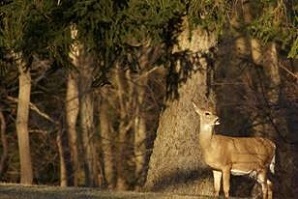Hunting and Trapping Newsletter
The New York State Department of Environmental Conservation sent this bulletin on 08/18/2021 05:43 PM EDT |
| DEC Delivers - Information to keep you connected and informed from the NYS Department of Environmental Conservation |
| Share or view as a web page || Update preferences or unsubscribe |
Hunting and Trapping Newsletter |
Fisher Permit UpdateEarlier this year DEC proposed regulations that would remove the requirement for the free special fisher trapping permit. Unfortunately, due to a publication error, these regulations will not be adopted prior to the start of the 2021 trapping season. To simplify the process for trappers this season, DEC has created a self-issued fisher trapping permit for trappers.
Trappers will not be required to submit the lower jaw, head, or carcass of any fisher taken during the 2021 trapping season. In addition, trappers do not have to complete or submit a Fisher Trapping Activity Log this season. Please note that a separate permit is required for trappers wishing to pursue marten. Contact DEC's Region 5 Wildlife Office in Warrensburg at 518-623-1240 to obtain a marten trapping permit. We encourage all trappers to stay involved by commenting on any proposed regulations, including the proposal to remove the special fisher trapping permit. For information on the proposed regulations and how to comment, visit DEC's website. We thank trappers for their continued cooperation in helping us manage furbearer populations in New York. Epizootic Hemorrhagic Disease (EHD) Confirmed in Ulster CountyDEC has confirmed that three white-tailed deer in the town of Esopus, Ulster County, died after contracting Epizootic Hemorrhagic Disease (EHD). DEC is following up on reports of dead deer in Dutchess, Ulster, and Westchester counties.
Once infected with EHD, deer usually die within 36 hours. EHD outbreaks are most common in the late summer and early fall when midges are abundant. EHD symptoms include fever, hemorrhage in muscle or organs, and swelling of the head, neck, tongue, and lips. A deer infected with EHD may appear lame or dehydrated. Frequently, infected deer will seek out water sources, and many succumb near a water source. There is no treatment or means to prevent EHD. The dead deer do not serve as a source of infection for other animals. EHD outbreaks do not have a significant long-term impact on deer populations, but deer mortality can be intense in small geographic areas. EHD is endemic in the southern states where there are annual outbreaks, so some southern deer have developed immunity. In the northeast, EHD outbreaks occur sporadically, and deer in New York have no immunity to this virus. Consequently, most EHD-infected deer in New York are expected to die. In the north, the first hard frost kills the midges that transmit the disease, ending the EHD outbreak. You should report sightings of sick or dying deer to the nearest DEC Regional Office or Environmental Conservation Police Officer. DEC will collect samples from deer and analyze data from deer reports to determine the extent of the outbreak. In addition, DEC has alerted Department of Agriculture and Markets veterinarians in the region to be aware of the disease and to report suspicious cases among captive deer. For more information on EHD, visit Cornell University's Wildlife Health Lab website. Photo courtesy of David Huizinga Hunting Licenses and Deer Management Permits on Sale Now
Did you know there is no need to rush to apply for a DMP? The chances of obtaining a DMP remain the same throughout the application period; DMPs are issued through an instant random selection process at the point of sale. The 2021 chances of selection for a DMP in each Wildlife Management Unit are available online, through license-issuing agents, or by calling the DMP Hotline at 1-866-472-4332. Visit DEC’s website for information on Deer season forecasts in your area. Photo courtesy of Katelynd Hill DEC Celebrates the Conservationist’s 75th Anniversary
That first issue of the Conservationist generated more than 9,000 reader letters, swamping the mailroom with subscription requests, suggestions, and questions. In addition to the bread-and-butter natural resource articles of its early days (e.g., hunting, fishing, forestry), the magazine grew to include more articles about environmental quality (e.g., air, water, and land pollution control) as the nation’s environmental consciousness grew after the first Earth Day in 1970. That was also the day the Conservation Department became the Department of Environmental Conservation. Throughout our 75-year history, the Conservationist has sought to entertain and educate, and to motivate people to make a positive difference in our world. To reference a concept that has been used to describe the cumulative impacts of water pollution runoff: while each of us may not think our individual actions make a difference, taken together, our voices and actions are magnified, and our collective efforts can bring about important environmental change for our local communities, which often benefits our state and nation, and our future. To encourage new subscribers and in celebration of the 75th anniversary of the magazine, DEC is offering a special $2 subscription rate for both in-person and online subscribers, including gift subscriptions, to the Conservationist during the upcoming Great New York State Fair, August 20 - September 6, 2021. This special rate will be limited to 7,500 online and in-person subscribers. To start receiving the Conservationist at home and in your email box, subscribe today by visiting DEC's website or calling 1-800-678-6399. |

 We are automatically sending fisher permits to those that applied for a Fisher or Fisher/Marten Trapping Permit in 2020. Trappers should expect to receive these permits by September 10th. Please sign and date the permit and carry it with you when trapping. This permit can also be
We are automatically sending fisher permits to those that applied for a Fisher or Fisher/Marten Trapping Permit in 2020. Trappers should expect to receive these permits by September 10th. Please sign and date the permit and carry it with you when trapping. This permit can also be  EHD virus is an often-fatal disease of deer that is transmitted by biting midges - small bugs often called no-see-ums or 'punkies.' The disease is not spread from deer to deer, and humans cannot be infected by deer or bites from midges. EHD was first confirmed in New York in 2007 with small outbreaks in Albany, Rensselaer, and Niagara counties, and in Rockland County in 2011. From early September to late October 2020, a large EHD outbreak occurred in the lower Hudson Valley, centered in Putnam and Orange counties, with an estimated 1,500 deer mortalities.
EHD virus is an often-fatal disease of deer that is transmitted by biting midges - small bugs often called no-see-ums or 'punkies.' The disease is not spread from deer to deer, and humans cannot be infected by deer or bites from midges. EHD was first confirmed in New York in 2007 with small outbreaks in Albany, Rensselaer, and Niagara counties, and in Rockland County in 2011. From early September to late October 2020, a large EHD outbreak occurred in the lower Hudson Valley, centered in Putnam and Orange counties, with an estimated 1,500 deer mortalities. Hunting licenses for the 2021-2022 season
Hunting licenses for the 2021-2022 season  DEC’s wildly popular magazine, the Conservationist, turns 75 this year! The first issue of the magazine was published in August of 1946 and had some familiar themes, including an article about a new law called the Forest Practice Standards Act, articles promoting the many recreational opportunities found at Cranberry Lake in St. Lawrence County, and the challenges faced by the Conservation Department (DEC’s predecessor) in constructing fire towers in the Adirondack and Catskill backcountry.
DEC’s wildly popular magazine, the Conservationist, turns 75 this year! The first issue of the magazine was published in August of 1946 and had some familiar themes, including an article about a new law called the Forest Practice Standards Act, articles promoting the many recreational opportunities found at Cranberry Lake in St. Lawrence County, and the challenges faced by the Conservation Department (DEC’s predecessor) in constructing fire towers in the Adirondack and Catskill backcountry.